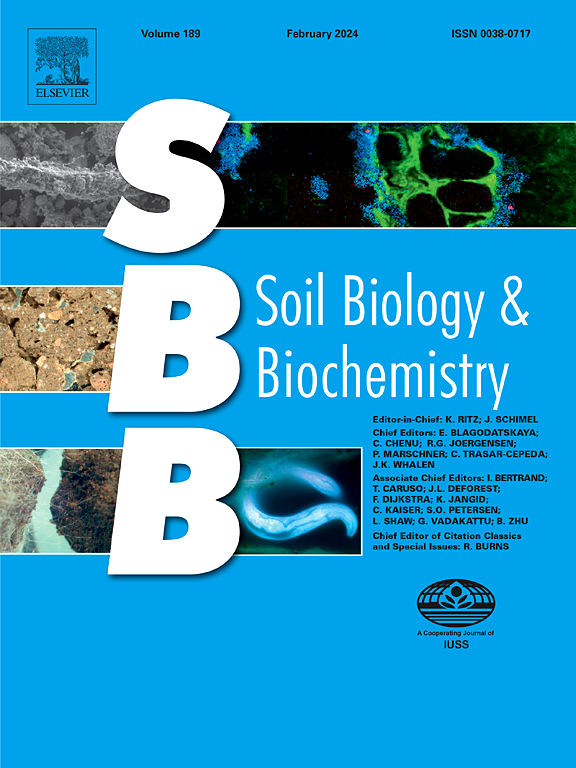Litter mixture effects on nitrogen dynamics during decomposition predominantly vary among biomes but little with litter identity, diversity and soil fauna
IF 10.3
1区 农林科学
Q1 SOIL SCIENCE
引用次数: 0
Abstract
Nitrogen (N) is essential for net primary production, with much of the required N in terrestrial ecosystems derived from recycling via litter decomposition. The diversity and identity of plant species and decomposer organisms affect N cycling during litter decomposition, yet the generality and magnitude of these effects remain uncertain. To fill this gap, a decomposition experiment with four leaf litter species that differed widely in initial litter quality was conducted including single species and all possible multispecies mixtures, with and without microarthropods access across a broad latitudinal gradient covering four major forest biomes of the Northern Hemisphere. The results showed that leaf litter N dynamics (both N loss and N immobilization) in single species treatments depended primarily on litter species identity and the local environmental context. We found strong mixture effects, that overall tended to increase N loss and to reduce 15N transfer. The relative mixture effects on N dynamics differed among forest biomes, but were little affected by the other factors we manipulated. The N loss of individual litter species in mixtures not only depended on litter identity and soil microarthropod access, but also on forest biomes; while 15N transfer depended strongly on litter mixing, independently of litter species richness or composition of the mixtures. Litter N dynamics were mainly driven by a small subset of litter traits, regardless of species richness and microarthropod access. Overall, our results highlight that litter mixture strongly affects N dynamics during decomposition, with the mixture effects predominantly varying among forest biomes but little with litter identity, diversity and microarthropod access. To improve predictions on how changes in tree species composition and diversity may impact nutrient dynamics in forest ecosystems in face of increasing N deposition, interactions between litter and soil but also within litter mixtures need closer attention.
垃圾混合物对分解过程中氮动态的影响主要因生物群落而异,但与垃圾特性、多样性和土壤动物群的关系不大
氮(N)是净初级生产所必需的,陆地生态系统所需的大部分氮来自于垃圾分解过程中的循环。植物物种和分解生物的多样性和特性会影响枯落物分解过程中的氮循环,但这些影响的普遍性和程度仍不确定。为了填补这一空白,我们在北半球四个主要森林生物群落的广阔纬度梯度上,对初始枯落物质量差异很大的四种枯落物进行了分解实验,包括单一物种和所有可能的多物种混合物,以及有无微型节肢动物的进入。结果表明,单一物种处理中的落叶氮动态(包括氮损失和氮固定)主要取决于落叶物种特征和当地环境背景。我们发现了强烈的混合物效应,总体上倾向于增加氮的损失和减少 15N 的转移。不同森林生物群落对氮动态的相对混合物效应各不相同,但几乎不受我们操纵的其他因素的影响。混合物中单个枯落物物种的氮损失不仅取决于枯落物的特征和土壤中微型节肢动物的进入,还取决于森林生物群落;而15N转移在很大程度上取决于枯落物的混合,与枯落物物种的丰富程度或混合物的组成无关。枯落物氮的动态主要受一小部分枯落物特征的驱动,与物种丰富度和微节肢动物的进入无关。总之,我们的研究结果突出表明,枯落物混合物对分解过程中的氮动态有很大影响,混合物的影响主要因森林生物群落而异,但与枯落物的特征、多样性和微节肢动物的进入关系不大。为了更好地预测在氮沉积不断增加的情况下,树种组成和多样性的变化会如何影响森林生态系统的养分动态,需要更密切地关注枯落物与土壤之间以及枯落物混合物内部的相互作用。
本文章由计算机程序翻译,如有差异,请以英文原文为准。
求助全文
约1分钟内获得全文
求助全文
来源期刊

Soil Biology & Biochemistry
农林科学-土壤科学
CiteScore
16.90
自引率
9.30%
发文量
312
审稿时长
49 days
期刊介绍:
Soil Biology & Biochemistry publishes original research articles of international significance focusing on biological processes in soil and their applications to soil and environmental quality. Major topics include the ecology and biochemical processes of soil organisms, their effects on the environment, and interactions with plants. The journal also welcomes state-of-the-art reviews and discussions on contemporary research in soil biology and biochemistry.
 求助内容:
求助内容: 应助结果提醒方式:
应助结果提醒方式:


